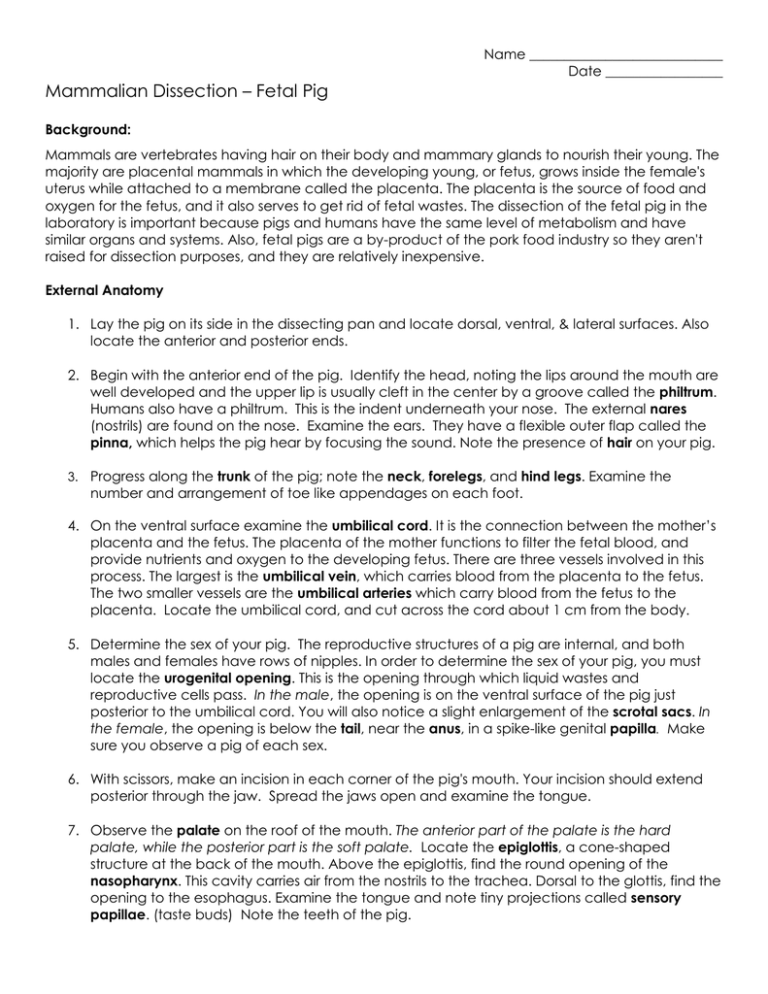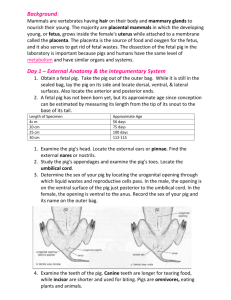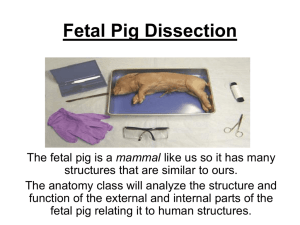Name Date Mammalian Dissection – Fetal Pig Background
advertisement

Name ____________________________ Date _________________ Mammalian Dissection – Fetal Pig Background: Mammals are vertebrates having hair on their body and mammary glands to nourish their young. The majority are placental mammals in which the developing young, or fetus, grows inside the female's uterus while attached to a membrane called the placenta. The placenta is the source of food and oxygen for the fetus, and it also serves to get rid of fetal wastes. The dissection of the fetal pig in the laboratory is important because pigs and humans have the same level of metabolism and have similar organs and systems. Also, fetal pigs are a by-product of the pork food industry so they aren't raised for dissection purposes, and they are relatively inexpensive. External Anatomy 1. Lay the pig on its side in the dissecting pan and locate dorsal, ventral, & lateral surfaces. Also locate the anterior and posterior ends. 2. Begin with the anterior end of the pig. Identify the head, noting the lips around the mouth are well developed and the upper lip is usually cleft in the center by a groove called the philtrum. Humans also have a philtrum. This is the indent underneath your nose. The external nares (nostrils) are found on the nose. Examine the ears. They have a flexible outer flap called the pinna, which helps the pig hear by focusing the sound. Note the presence of hair on your pig. 3. Progress along the trunk of the pig; note the neck, forelegs, and hind legs. Examine the number and arrangement of toe like appendages on each foot. 4. On the ventral surface examine the umbilical cord. It is the connection between the mother’s placenta and the fetus. The placenta of the mother functions to filter the fetal blood, and provide nutrients and oxygen to the developing fetus. There are three vessels involved in this process. The largest is the umbilical vein, which carries blood from the placenta to the fetus. The two smaller vessels are the umbilical arteries which carry blood from the fetus to the placenta. Locate the umbilical cord, and cut across the cord about 1 cm from the body. 5. Determine the sex of your pig. The reproductive structures of a pig are internal, and both males and females have rows of nipples. In order to determine the sex of your pig, you must locate the urogenital opening. This is the opening through which liquid wastes and reproductive cells pass. In the male, the opening is on the ventral surface of the pig just posterior to the umbilical cord. You will also notice a slight enlargement of the scrotal sacs. In the female, the opening is below the tail, near the anus, in a spike-like genital papilla. Make sure you observe a pig of each sex. 6. With scissors, make an incision in each corner of the pig's mouth. Your incision should extend posterior through the jaw. Spread the jaws open and examine the tongue. 7. Observe the palate on the roof of the mouth. The anterior part of the palate is the hard palate, while the posterior part is the soft palate. Locate the epiglottis, a cone-shaped structure at the back of the mouth. Above the epiglottis, find the round opening of the nasopharynx. This cavity carries air from the nostrils to the trachea. Dorsal to the glottis, find the opening to the esophagus. Examine the tongue and note tiny projections called sensory papillae. (taste buds) Note the teeth of the pig. Internal Anatomy of the Fetal Pig 8. Use two pieces of strong twine and tie one around a wrist and one around an ankle of the pig. Pull each under the dissecting pan and tightly tie the twine to the opposite wrist or ankle. 9. Make incisions as indicated in the diagram. Cut carefully with scissors to avoid damaging the underlying organs. Note--when you cut through the thoracic cavity, you will encounter bone. You must cut through this bone to expose the underlying organs. 10. Cut the skin flaps back close to the back bone so they will remain open. Be careful not to injure the kidneys. Pull back the two flaps of skin (you will need to cut the diaphragm along the sides) and muscle to view the internal organs. Locate the umbilical vein inside the abdomen. Once determined, cut it and lay back the cord and its strip of skin. THORACIC CAVITY 11. Observe the pericardium, a thin, tough membrane surrounding the heart. Locate the 2 atria and 2 ventricles. Note the difference in texture and colour. 12. The pig may have been injected with colored latex which makes it easy to locate the veins (blue) and the arteries (red). Try to trace and identify as many of the blood vessels off the heart as possible. You may be able to locate the anterior and posterior vena cava, the pulmonary veins which carry blood from the lungs to the left atrium. The most noticeable artery is the aorta. The aorta curves to the left and passes cranially along the dorsal side of the thoracic and abdominal wall. The next largest artery is the pulmonary artery. It arises from the anterior portion of the right ventricle and soon divides into the right and left pulmonary arteries. 13. Find the trachea, a tube that extends from the neck to the chest. It is white and lined with cartilage. The enlargement at the anterior end of the trachea is the larynx (voice box) which contains the vocal cords. Lying atop the trachea, locate the pinkish-brown, V shaped structure called the thyroid gland. This gland secretes hormones that control growth and metabolism. The trachea splits in the chest cavity into two bronchi, which lead into the lungs. ABDOMINAL CAVITY Digestive System 14. The large, reddish-brown organ that occupies much of the abdominal space is the liver. Gently lift it up and locate the gall bladder which is on the pig’s right side. 15. The diaphragm (a thin brown muscular tissue) is the tough muscle which separates the thoracic and abdominal cavities. The esophagus goes through it to the stomach. The esophagus carries the food from the pharynx to the stomach. Locate the stomach on the upper left side of the abdominal cavity, underneath the liver. The stomach resembles a pouch in appearance and is connected to the esophagus at its anterior end. 16. Observe that the small intestine is not loose in the abdominal cavity but is held in place the by the mesentery, a thin clear membrane. Check and look for veins and arteries in the mesentery that carry absorbed nutrients to the liver through the hepatic-portal vein. The large intestine appears as a compact coil and is larger in diameter than the small intestine. Locate the junction of the large and small intestine. Below this junction may be found a small pouchlike structure called the caecum. This is the same item that is the appendix in humans. It helps in the slow digestion of plant materials in other animals. 17. Follow the large intestine (colon) to the rectum. This lies in the dorsal wall of the abdominal cavity and is the straight end portion of the large intestine. Water is absorbed by the body in the large intestine. Waste material stored in the rectum leaves the body through the anus. 18. Locate the pancreas which is a large white granular organ located below the stomach. The pancreas makes a variety of digestive enzymes that travel to the small intestine through the pancreatic duct. This duct is difficult to find in the pig. The red elongated organ extending around the outer curvature of the stomach is the spleen. It resembles a tongue. The spleen helps destroy old red blood cells. Urinary and Reproductive Systems 19. To find the kidneys, look for two lumps low in the abdominal cavity. They are behind a membrane called the peritoneum. You will need to carefully remove the peritoneum to see the bean-shaped kidneys. 20. Locate the ureter originating from the concave side of the kidney. Follow the ureter posteriorly until it joins the urinary bladder. The urinary bladder lies between the umbilical arteries and temporarily stores liquid wastes filtered from the blood. 21. Male: Find the scrotal sacs at the posterior end of the pig (between the legs), testis are located in each sac. Open the scrotal sac to locate the testis. On each teste, find the coiled epididymis. Sperm cells produces in the teste pass through the epididymis and into a tube called the vas deferens (in humans, a vasectomy involves cutting this tube).The penis is difficult to find, but can be located by cutting away the skin on the flap near the umbilical cord. This tube-like structure eventually exits out the urogenital opening, also known as the urethra. 22. Female: In the female pig, locate two bean shaped ovaries located just posterior to the kidneys and connected to the curly oviducts. Trace the oviducts toward the posterior to find that they merge at the uterus. Trace the uterus to the vagina. The vagina will actually will appear as a continuation of the uterus and will be difficult to distinguish.





